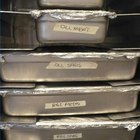
George Doyle/Stockbyte/Getty Images
Hot ham sandwiches provide a simple meal choice for a large event or afternoon picnic, but keeping the ham warm as everyone serves themselves can prove challenging. It's vital that the sandwich slices are kept at a safe temperature until they are eaten or stored; otherwise, they can harbor illness-causing bacteria.
Safe Temperature
Illness-causing bacteria can blossom in ham slices if they fall into the danger zone. For heated, precooked ham sandwich slices, the danger zone is between 40 and 140 degrees Fahrenheit. Generally the ham remains safe to eat for two hours after you remove it from refrigeration or heat. If you're trying to keep ham warm for sandwiches, a food thermometer will let you monitor the temperature at all times so the meat doesn't fall into the danger zone.
Preparation
Cook or heat the ham as close to serving time as possible. If heating ham from the freezer, move it to the refrigerator to thaw 24 hours prior. Thawing at room temperature can cause bacteria growth. Large whole hams intended for slicing may take up to 48 hours to thaw completely in the refrigerator. If you must heat the ham in advance, cover the pan with foil and place a thermometer into the meat so you can view it easily. Keep it in the oven at the lowest setting until you are ready to set it out for serving. The foil prevents the ham from drying out in the oven.
Heat Sources
You must plan ahead to keep the ham warm once you set it out for serving. A slow cooker set to the warm setting works well if the ham is precut into slices for easy serving. The ham may dry out if kept in the slow cooker for more than an hour. Prevent this by placing 1/2 inch of water in the slow cooker. Set the ham on a rack so the meat is kept above the water. Chafing dishes use a gel fuel canister to provide steady bottom heat to the dish. These heating dishes are commonly used at catered events and buffets to keep food at a safe temperature. Disposable models are available for home use, and work well for ham slices.
Packed Lunches
It's more difficult to keep the ham warm for a packed lunch or picnic. Heat the ham well into the safe zone immediately before packing it. Leave the ham in the hot heating dish to minimize the amount of heat lost, since a cool dish immediately begins leaching warmth from the meat. Insulated packs for transporting lunches or casserole dishes help keep the ham warm. You can create your own insulated pack by wrapping the dish with foil and packing it into a bag filled with crumpled newspaper, which adds further insulation. Follow the two-hour rule: Use the warm slices within two hours to prevent contamination.
Related Articles

How to Reheat a Ham

Containers That Keep Food Hot

Uses of Thermal Insulators
How to Make Spiral Ham in Crock-Pot

How to Heat Lasagna From the Fridge

How to Store Uncooked Smoked Ham
Tips on How to Cook a Spiral Ham

Can a Cream Cheese-Decorated Cake Be ...
What Is the Safe Cooking Temperature ...

The Difference Between a Chafing Dish & ...

Catering Tips for Delivering Food

How Should I Store Hot Sandwiches for ...
How Long Can Leftovers Be Refrigerated?

How to Keep Baked Goods Moist Overnight

How to Heat Pre-Cooked Hams

How to Reheat Lasagna

How Long to Cool a Quiche

Cooking Instructions for a Ridge Creek ...

The Best Temperature for Wax Hair ...

How Do I Roast a Picnic Ham?
References
Writer Bio
Jenny Harrington has been a freelance writer since 2006. Her published articles have appeared in various print and online publications. Previously, she owned her own business, selling handmade items online, wholesale and at crafts fairs. Harrington's specialties include small business information, crafting, decorating and gardening.
Photo Credits
George Doyle/Stockbyte/Getty Images